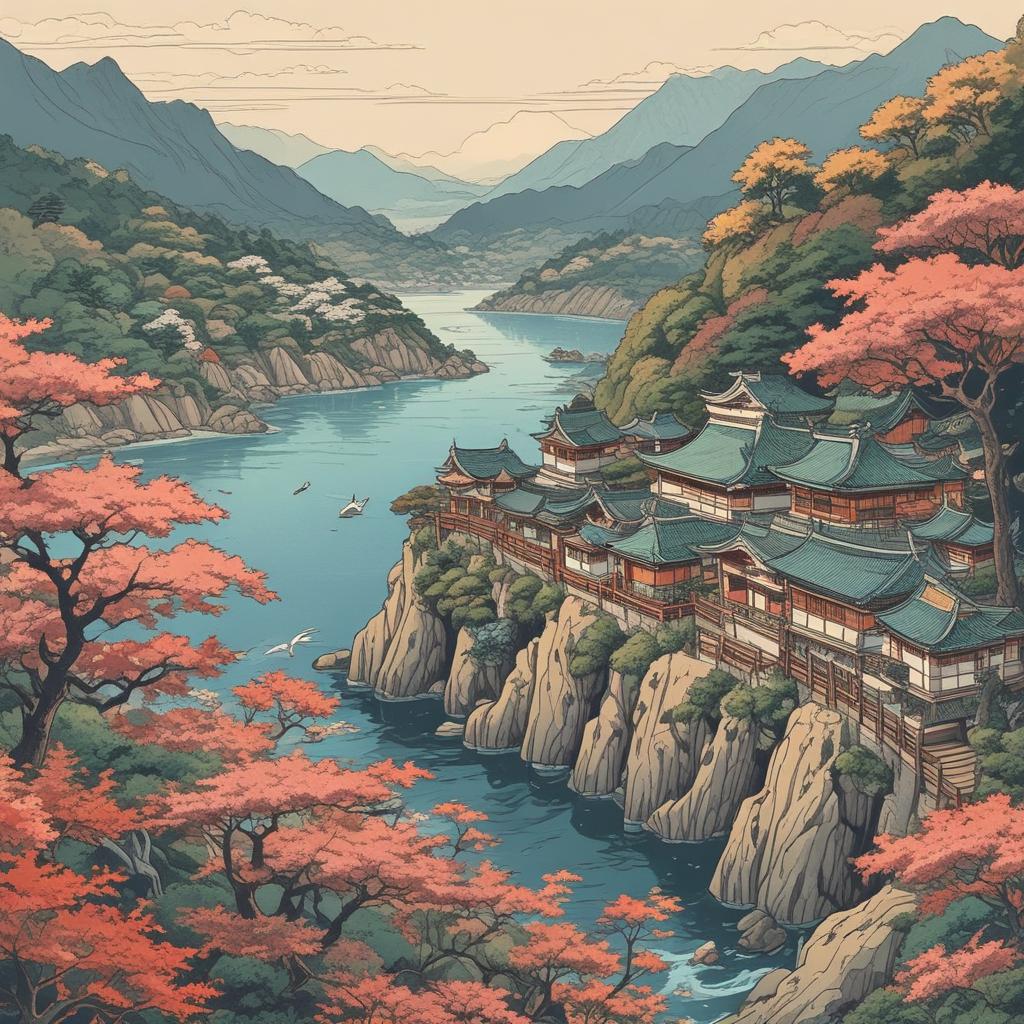Hello to all history enthusiasts! Today, we’ll shine a spotlight on Shikoku, a region deeply entrenched in the ancient history of Japan, particularly focusing on the areas historically known as Awa (now Tokushima Prefecture) and Iyo (now Ehime Prefecture). Shikoku isn’t just another travel destination; it’s a place where deep history, culture, and mystique intertwine. Through this article, I hope to share the allure of Shikoku with many more people.
Historical Background of Awa
Awa faces the Seto Inland Sea and has thrived since ancient times as a key maritime hub. The region is dotted with remains from the Yayoi period, narrating tales of ancient lives and interactions. Particularly noteworthy is the Kofun period, marked by the construction of large burial mounds, signifying its role as a political center. Alongside its rich natural scenery connected to the sea, Awa offers a glimpse into the politics and culture of ancient times.
The Charms of Iyo
On the other hand, Iyo is home to the mystical Mount Ishizuchi, a significant site for ancient religious rituals, highlighting the area’s importance since ancient times. Iyo was a hub for ancient iron production, thanks to its rich iron resources, playing a crucial role in the economic activities of the period. The region is also part of the Shikoku Pilgrimage route, revered since ancient times as a path of faith, cherished by many.
Shikoku Pilgrimage – A Spiritual Culture from the Past
Shikoku is famously known as the “land of pilgrimage.” Traveling through the eighty-eight sacred sites of Shikoku is an ancient form of religious journey, bustling with people seeking spiritual cleansing and new beginnings. Understanding how this religious backdrop has influenced the region’s culture and society can deepen one’s interest in Shikoku’s profound history.
Conclusion
As such, Shikoku is not just any region; it is a valuable place where Japan’s history, especially ancient history, is vividly preserved. Visiting Awa and Iyo allows one to experience the integration of local history, culture, and nature. Shikoku is a must-visit for history buffs or travelers seeking new discoveries. Stepping out from the pages of history and visiting these lands personally can lead to new insights and emotional encounters. I hope this article resonates with many, spreading far and wide through shares. I look forward to your comments and shares as we explore Shikoku together!
投稿者: kenichi02122000gmailcom
四国地方の魅力を再発見!―古代日本の歴史が息づく「阿波の国」と「伊予の国」
こんにちは、歴史探訪が趣味の皆さん!今回は、日本の四国地方にスポットを当てて、古代の歴史が色濃く残る「阿波の国」と「伊予の国」の魅力に迫りたいと思います。四国はただの旅行先ではなく、深い歴史と文化、そして神秘が交錯する地です。この記事を通じて、そんな四国の魅力を多くの人に知ってもらえたら嬉しいです。
阿波の国の歴史的背景
阿波の国(現在の徳島県)は、瀬戸内海に面し、古代から海上交通の要所として栄えました。この地域には弥生時代の遺跡が点在し、古代の人々の生活や交流の様子を今に伝えています。特に注目すべきは、大きな古墳が造られた古墳時代。政治の中心地としても重要な役割を果たしていたことがうかがえます。海とつながる豊かな自然と共に、古代の政治や文化の息吹を感じることができるのが阿波の国の魅力です。
伊予の国の魅力
一方、伊予の国(現在の愛媛県)には、神秘的な石鎚山がそびえ立ちます。石鎚山は古代宗教の儀式の場としても重要で、この地域が古代から特別な意味を持っていたことを示しています。伊予は鉄資源が豊富で、古代の鉄器生産の中心地として栄え、経済活動の一翼を担っていました。また、四国八十八箇所の遍路道がこの地を通ることもあり、古代から続く信仰の道として、多くの人々に親しまれています。
四国遍路―古代から続く精神文化
四国は「遍路の地」としても知られています。四国八十八箇所を巡る遍路は、古代から続く宗教的な旅であり、精神的な浄化や新たな始まりを求める人々でいつも賑わいます。この宗教的な背景が、地域の文化や社会にどれほど影響を与えているかを理解すると、四国の深い歴史に更に興味を持つかもしれません。
まとめ
このように、四国地方はただの地方ではなく、日本の歴史、特に古代の歴史を今に伝える貴重な場所です。阿波の国と伊予の国を訪れることで、その地の歴史や文化、自然と一体となった感覚を体験することができるでしょう。歴史好きな方、または新たな発見を求める旅行者にとって、四国は必見の地です。
ぜひこの記事が皆さんの興味を引き、四国地方のさらなる探訪へとつながれば幸いです。歴史のページから一歩出て、直接その土地を訪れてみることで、新たな発見や感動があるはずです。そして、この記事が少しでも多くの方々に共感され、広くシェアされることを願っています。皆さんのコメントやシェアをお待ちしております!
Learning Deep Lessons from the Demon’s Castle in the Legend of Momotaro
Have you ever heard of the story of “Momotaro”? It’s a famous Japanese folk tale where the hero, Momotaro, along with his companions, battles demons to bring peace to the land. But why do the demons depicted in the story, especially the lord of the Demon’s Castle, Ura, gain popularity despite being villains?
This phenomenon goes beyond the mere charm of the story, holding the key to understanding the depth of Japanese culture. Japanese culture doesn’t rely on a simple dichotomy of good and evil but values the complexity and multifaceted nature of things. The deep affection and fascination for characters like Ura and other demons, despite their villainous roles, stem from this cultural backdrop.
The Complexity of Villains
One reason for the popularity of demon characters like Ura is the fact that they are not just mere villains. In Japanese stories, demons and villains often come with their own stories, backgrounds, and struggles. There’s an attempt to understand why they act the way they do and what they feel, making them characters with whom people can empathize, portraying them as more human and relatable.
The Appeal of Strength and Rebellion
Moreover, the strength and spirit of rebellion that characters like the demons possess appeal to many. These characters are sometimes seen as symbols of resistance against oppression and injustice or as embodiments of courage to face difficulties with self-belief. This empathy towards such characters resonates especially in modern society, which values self-actualization and independence.
Demons in Subculture
In the realm of Japanese subculture, demons and villainous characters often develop their own fan bases. These characters, with their unique designs and distinctive stories, stimulate the imagination of fans and attract deep interest. Characters like Ura provide fans with new perspectives and opportunities for thought through their complexity and dynamism.
Conclusion
The reason why a villainous character like Ura is beloved lies in their complexity, strength, and the deep cultural roots they represent. These elements make them not just mere antagonists but enrich the stories and culture with their diversity. Our fascination with such characters may stem from their deep humanity, rebellious spirit against society, and the profound messages conveyed through their stories.
I hope this blog post serves as an opportunity to view the legend of Momotaro and its demons from a new perspective. If this article resonates with you, feel free to share it and expand the discussion on this intriguing topic.
鬼の城から学ぶ、桃太郎の伝説に隠された深い教訓
皆さんは「桃太郎」という物語を聞いたことがありますか?日本の有名な民話で、正義の味方である桃太郎が、仲間たちと共に鬼たちを退治する物語です。しかし、その物語の中で描かれる鬼たち、特に鬼ノ城の主である温羅はなぜ、悪役でありながらも多くの人々に愛され、人気があるのでしょうか?
この現象は、ただの物語の魅力を超えて、日本文化の深い理解につながる鍵を握っています。日本の文化は、表面的な善悪の二元論ではなく、物事の多面性を重んじる哲学に根ざしています。温羅やその他の鬼たちが悪役として描かれながらも、彼らに対する深い共感や魅力を感じる人々がいるのは、この文化的背景が大きく影響しています。
悪役の多面性
温羅のような鬼キャラクターが人気を博する一つの理由は、彼らが単なる悪役ではないという事実にあります。日本の物語において、鬼や悪役はしばしば、彼ら自身の物語や背景、苦悩を持っています。これらのキャラクターには、ただ敵対するだけでなく、彼らがなぜそのような行動を取るのか、何を感じているのかを理解しようとする試みがあります。これは、彼らをより人間味があり、共感しやすいキャラクターとして描き出しています。
強さと反逆の魅力
また、温羅のような鬼たちが持つ力強さや、既存の秩序に反逆する精神は、多くの人々にとって魅力的です。これらのキャラクターは、時には抑圧や不公平に立ち向かう象徴として、また時には自分たちの力を信じて困難に立ち向かう勇気を持つ存在として見られます。このようなキャラクターに対する共感は、自己実現や自立の価値を重んじる現代社会において特に強く響きます。
サブカルチャーとしての鬼
さらに、日本のサブカルチャーにおいては、鬼や悪役キャラクターが独自のファンベースを築き上げることがよくあります。これらのキャラクターは、独創的なデザインや個性的な物語を通じて、ファンの想像力を刺激し、深い興味を引き寄せます。温羅のようなキャラクターは、その複雑さやダイナミズムが、ファンに新たな視点や思考の契機を提供します。
まとめ
鬼ノ城の主、温羅が悪役であるにも関わらず愛される理由は、彼らが持つ多面性、力強さ、そして文化的背景に深く根ざしています。これらの要素は、彼らを単なる敵ではなく、物語や文化の多様性を豊かにする存在として捉えさせます。私たちがこのようなキャラクターに魅力を感じるのは、彼らが持つ深い人間性や、社会に対する反逆の精神、そして物語を通じて伝えられる深いメッセージに共感するからかもしれません。
このブログ記事が、桃太郎の伝説とその中の鬼たちに新たな視点を持って接するきっかけになれば幸いです。そして、もしこの記事が皆さんの心に響いたなら、ぜひシェアして、この興味深い話題についての議論を広げていただければと思います。
Japan’s Mysterious 4th Century: Empathy and Discovery from the Past
In the tapestry of Japan’s history lies a period referred to as the “mysterious 4th century.” This era, spanning the late 3rd to the 4th century, approximately 1700 years ago, is characterized by a scarcity of historical records, shrouded in mystery. Yet, it is this very lack of information that stirs our imagination and fosters a deep empathy towards ancient Japan.
Empathy with Political Diversity
Archaeological findings and Chinese historical texts suggest that during this time, the Japanese archipelago was home to various regional powers. Each of these entities had its unique political system and embraced different cultures and technologies. This political diversity offers a parallel to our contemporary society, where diverse cultures and ideologies coexist. The varied regional powers of yesteryears can be seen as a precursor to modern Japan’s multifaceted society.
Empathy with Social Diversity
With the advancement of agricultural society, differences in the scale and structure of settlements emerged. The beginning of the Kofun period, marked by the appearance of large tomb systems, indicates changes in the societal hierarchy and power structures. These burial mounds varied significantly in shape and size across regions, reflecting the cultural and societal distinctions of each area. Today, we can relate to our roots and the uniqueness of our local communities, deepening our understanding of each other’s backgrounds.
Empathy with Cultural Diversity
During this era, the Japanese archipelago was influenced by external cultures. The influx of new technologies and cultural practices from China and the Korean Peninsula is evident in the artifacts discovered, such as pottery, metalwork, and ornaments. The widespread use of iron tools revolutionized agriculture and warfare, significantly impacting societal development. In contemporary times, we continue to enrich our lives through the adoption of foreign cultures and technologies. This cultural diversity fosters an environment where we can embrace new perspectives and ideas, enhancing our own culture in the process.
Empathy with the Past, Steps Towards the Future
The mysterious 4th century reveals the diverse history and culture of Japan, from past to present, and into the future. Like us, the people of this era interacted with a variety of cultures, adopting and adapting them to enrich their own. This historical journey not only deepens our empathy for the past but also inspires us to consider the possibilities of the future. By embracing diversity, we can continue to grow together, building a richer culture.
Reflecting on this enigmatic era allows us to reconnect with our roots and appreciate the importance of accepting different cultures and values. Though the mysterious 4th century is a tale from the distant past, it resonates closely with us, filled with empathy and discoveries.
日本の空白の4世紀を旅する:過去への共感と発見
日本の歴史の中で、空白の4世紀と呼ばれる時代があります。これは、約1700年前、3世紀末から4世紀にかけての時期で、歴史資料がほとんど残っていない謎に満ちた時代です。しかし、この謎が多い時代こそが、私たちの想像力をかき立て、日本の古代に対する深い共感を生み出します。
政治の多様性への共感
考古学的な発見や中国の歴史書を手がかりに、この時代の日本列島にはいくつもの地域権力が存在していたことが示唆されます。各地域権力は独自の政治体制を持ち、異なる文化や技術を受容していたのです。この政治的多様性は、今日の私たちが生きる多様な社会との共感点を提供します。異なる文化や考え方が共存する現代の日本も、かつての多様な地域権力の集合体と言えるかもしれません。
社会の多様性への共感
農耕社会の発展と共に、集落の規模や構造の違いが生まれました。古墳時代の始まりとされるこの時代には、社会における権力者やその権力構造の変化が見られる大型の墓制が現れます。これらは地域ごとに異なる文化や社会構造を反映しています。私たちも、自分たちのルーツや地域社会の独自性を再認識し、それぞれの背景に対する理解を深めることができるでしょう。
文化の多様性への共感
この時代の日本列島は、外からのさまざまな影響を受けていました。中国や朝鮮半島からの影響を受け、新たな技術や文化が日本にもたらされました。鉄器の使用の普及は、農業の効率化や武器としての利用など、社会全体に大きな影響を与えました。現代もまた、外からの文化や技術が私たちの生活を豊かにしています。この文化的多様性への共感を通じて、私たちは新たな価値観やアイデアを受け入れ、自分たちの文化を豊かにしていくことができるのです。
過去への共感、未来への一歩
空白の4世紀を通じて見えてくるのは、過去から現代へ、そして未来へと続く、日本の歴史と文化の多様性です。この時代の人々も、私たちと同じように多様な文化と触れ合い、それを自分たちのものとして発展させてきました。この歴史的な旅は、私たちに過去への深い共感とともに、未来への新たな可能性を感じさせてくれます。私たちの社会も、この多様性を受け入れ、共に成長していくことで、より豊かな文化を築いていくことができるでしょう。
この謎に満ちた時代に思いを馳せることで、私たちは自分たちのルーツを見つめ直し、異なる文化や価値観を受け入れる大切さを再確認できるのです。日本の空白の4世紀は、遠い過去の話ではありますが、私たちにとって非常に身近な、共感と発見に満ちた時代なのです。
The Role of the Present in Preserving the Past: The Significance of Japan’s Ancient Tumuli”
Hello, everyone. Today, I want to discuss a special topic that takes us back through time. We’re going to explore why Japan’s ancient tumuli, or kofun, are not excavated. These mounds are more than just ancient hills of earth. They’re messages from the past, cultural heritages, and gifts from our ancestors.
Respect and Protection: The Bond between Modern Society and Ancient Tumuli
Are you aware of why these tumuli are so special? Built between the 3rd and 7th centuries, they are some of the most mystical relics in Japanese history. However, they are more than just historical sites. They hold significant meaning for many Japanese people today, representing respect for ancestors and deep reverence for history.
Delicate Process: The Technique of Excavating Tumuli
Excavating these tumuli is not just about digging. It’s like a time travel to the past, requiring extremely delicate techniques and profound expertise. A single mistake could mean the loss of invaluable historical information forever. This is why we need to treat these tumuli with care and respect.
Time and Resources: The Reality of Excavation
Did you know that excavating tumuli requires an enormous amount of time and resources? In Japan, decisions must be made carefully about which tumuli to excavate, given the limited budget. This is a crucial decision for connecting our historical heritage to the future.
The Meaning of Cultural Heritage: Tumuli to Us
Finally, tumuli are not just remnants of the past. They are an essential part of our culture, identity, and history. Through these tumuli, we can connect with the lives, beliefs, and dreams of our ancestors.
By preserving and valuing these tumuli, we bridge the past and the present, building a pathway to the future. I hope this blog helps you appreciate the deep historical significance of these ancient tumuli and the modern role in preserving them.
Let’s cherish the message these Japanese tumuli convey to us. It’s our collective responsibility to honor the past and build the future.
過去を守る現代の役割:日本の古墳が語る歴史の重み
こんにちは、皆さん。今日は、私たちの心を遠い過去に連れて行く特別なテーマについてお話ししたいと思います。それは、なぜ日本の古墳が発掘されないのか、という話です。古墳は、ただの古い土の山ではありません。それは時を超えたメッセージ、文化的遺産、そして私たちの先祖からの贈り物です。
尊重と保護:古墳と現代社会の絆
皆さんは、古墳がなぜ特別なのかをご存知ですか?これらは、3世紀から7世紀に造られた、日本の歴史の中で最も神秘的な遺跡の一つです。しかし、これらの古墳はただの遺跡ではなく、今もなお多くの日本人にとって重要な意味を持っています。それは、祖先への尊敬と、歴史に対する深い敬意の表れなのです。
繊細な手作業:古墳発掘の技術
古墳の発掘は、単なる掘削作業ではありません。それは、過去への一種のタイムトラベルであり、極めて繊細な技術と深い専門知識が必要です。過ちがあれば、貴重な歴史的情報を永遠に失う可能性があります。だからこそ、私たちは古墳を慎重に、そして敬意を持って扱う必要があるのです。
時間と資源:発掘の現実
皆さん、古墳の発掘には膨大な時間と資源が必要だということをご存知でしょうか。日本では、限られた予算の中で、どの古墳を発掘するかを慎重に選ばなければなりません。これは、私たちの歴史的遺産を未来へと繋ぐための大切な決断です。
文化的遺産の意味:私たちにとっての古墳
最後に、古墳は単に過去の名残ではありません。それは、私たちの文化、アイデンティティ、そして歴史を形作る重要な部分です。これらの古墳を通して、私たちは先人たちの生活、信仰、そして夢に触れることができます。
私たちは、古墳を守り、大切にすることで、過去と現代をつなぎ、未来への橋を築くことができるのです。このブログを読んで、皆さんも古墳が持つ深い歴史的意義と、それを守る現代の役割について、少しでも感じていただければ幸いです。
最後に、日本の古墳が私たちに伝えるメッセージを、一緒に大切にしていきましょう。それは、過去を敬い、未来を築くための、私たち全員の責任です。
Shintoism and Christmas in Japan: The Fusion of Diverse Cultures
Hello, everyone! Today, I want to delve into the fascinating relationship between Shintoism and Christmas in Japan, focusing on the captivating diversity they both embody. Japanese culture is renowned for its skillful blend of different values and traditions. By exploring this phenomenon in depth, we can rediscover the richness that lies at the heart of our everyday culture.
What are the “Eight Million Gods” in Shintoism?
In Shintoism, the term “Eight Million Gods” (yaoyorozu no kami) refers to the countless deities present in nature and human life. This concept, recognizing divinity in every element of nature – mountains, rivers, trees, and even the wind and rain – is deeply connected to the diversity of Japanese culture.
How Japan Embraces Christmas
Conversely, while Christmas originates as a Christian holiday, in Japan, it transcends its religious connotations to be widely celebrated as a cultural event. This demonstrates Japan’s ability to adopt foreign cultures, interpreting and enjoying them in its unique way.
The New Values Created by the Fusion of Different Cultures
The diversity in Shintoism and the acceptance of Christmas might seem contradictory at first glance, but they actually share many commonalities. While Shintoism finds divinity in diverse natural phenomena and human activities, embracing the world inclusively, the way Christmas is embraced in Japan shows a willingness to understand and enjoy foreign cultures in a uniquely Japanese manner.
The Evolution of Japanese Culture
Thus, Japan has historically integrated various cultures and values, creating its unique diversity. The concept of “Eight Million Gods” in Shintoism, symbolizing the diversity of the natural and human world, influences how modern Japanese society accepts foreign cultures, like the Western holiday of Christmas.
Conclusion
Japanese culture continually evolves through the acceptance and fusion of diverse elements at its foundation. Living within this culture, by embracing diversity, we can build a richer worldview.
I hope you all enjoy exploring the diverse aspects of Japanese culture. I’m looking forward to your comments and thoughts! Stay tuned for the next blog!
日本の神道とクリスマス:異文化の融合が生み出す多様性
こんにちは、皆さん!今日は日本の神道とクリスマスの関連性について、その魅力的な多様性に焦点を当てて考察してみたいと思います。日本の文化は、異なる価値観や伝統を絶妙に融合させることで知られています。この現象を深く掘り下げることで、私たちの日常に根付いている豊かな文化の奥深さを再発見できるでしょう。
神道の「八百万の神」とは?
神道における「八百万(やおよろず)の神」という表現は、自然界や人間の生活に息づく無数の神々を指します。山、川、木々、さらには風や雨まで、あらゆる自然要素に神性を見出すこの考え方は、日本文化の多様性と深いつながりを持っています。
クリスマスの日本での受け入れ方
一方、クリスマスはもともとキリスト教の祭日ですが、日本では宗教的な意味合いを超え、広く文化的なイベントとして受け入れられています。これは、日本が異文化を取り入れ、独自の形で解釈し、楽しむ能力を持っていることの証です。
異文化との融合が生み出す新たな価値
神道の多様性とクリスマスの受容は、表面的には相反するように見えますが、実は共通する点が多いのです。神道が多様な自然現象や人間活動に神性を見出し、世界を包括的に捉えようとするのに対し、クリスマスの受け入れ方は、異文化を理解し、日本独自の形で楽しむ姿勢を示しています。
日本文化の進化
このように、日本では異なる文化や価値観を受け入れ、それを自国の文化に織り交ぜることで、独自の多様性を生み出してきました。神道の「八百万の神」の概念が示す自然界と人間世界の多様性は、現代の日本社会における異文化の受け入れ方、例えばクリスマスのような西洋の祭日の取り入れ方にも影響を与えています。
結論
日本の文化は、根底にある多様性の受容と融合によって、常に進化し続けています。私たちはこの文化の中で生き、多様性を受け入れることで、より豊かな世界観を築くことができるのです。
それでは、皆さんも日本の多様な文化を楽しんでみてはいかがでしょうか。コメントや感想をお待ちしています!次回のブログもお楽しみに!








